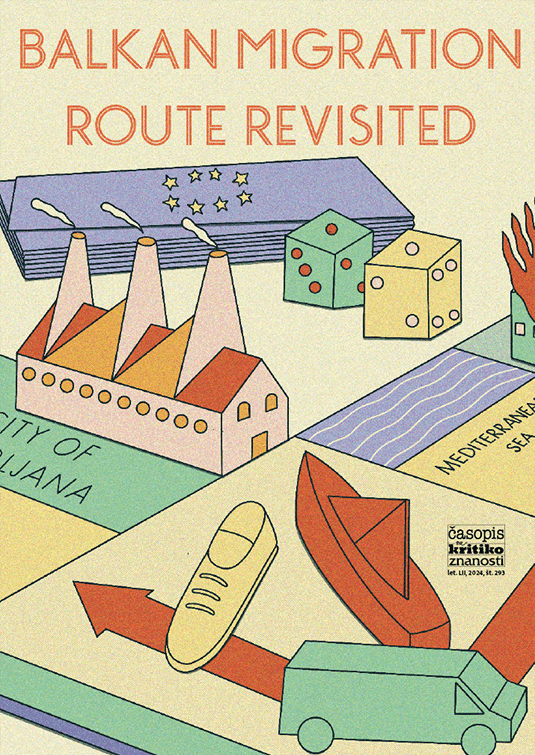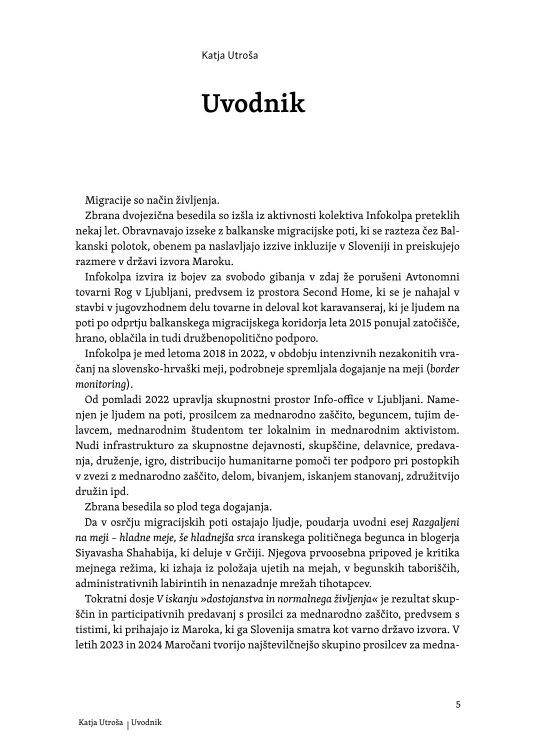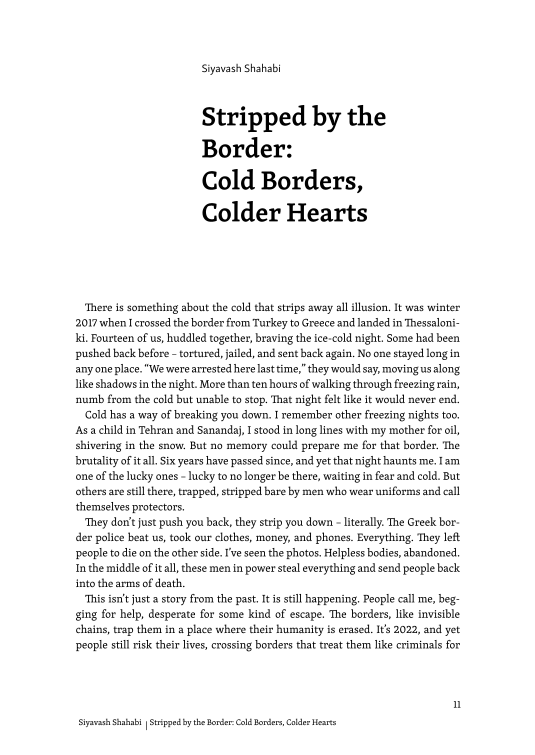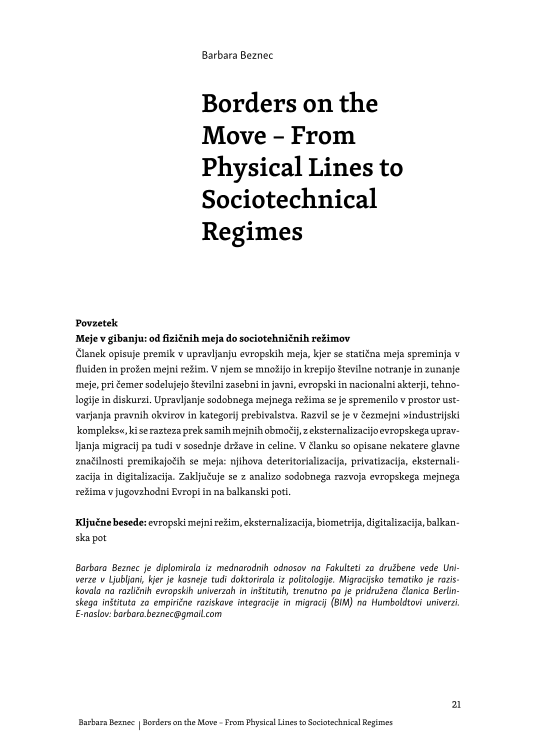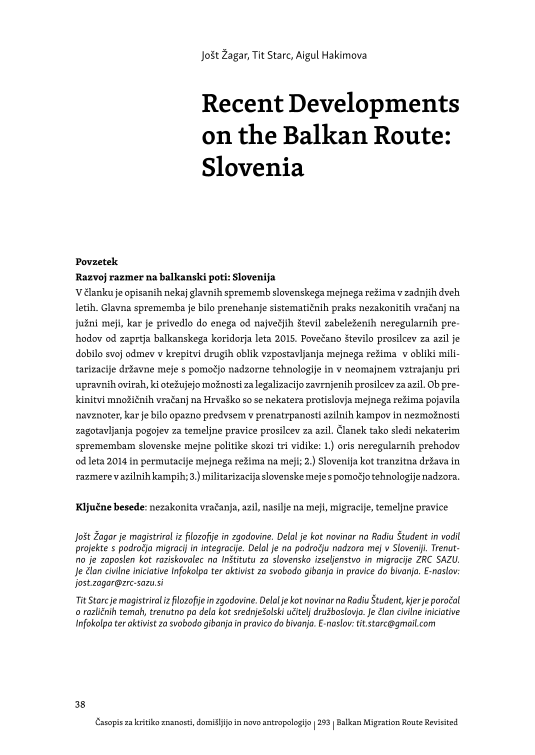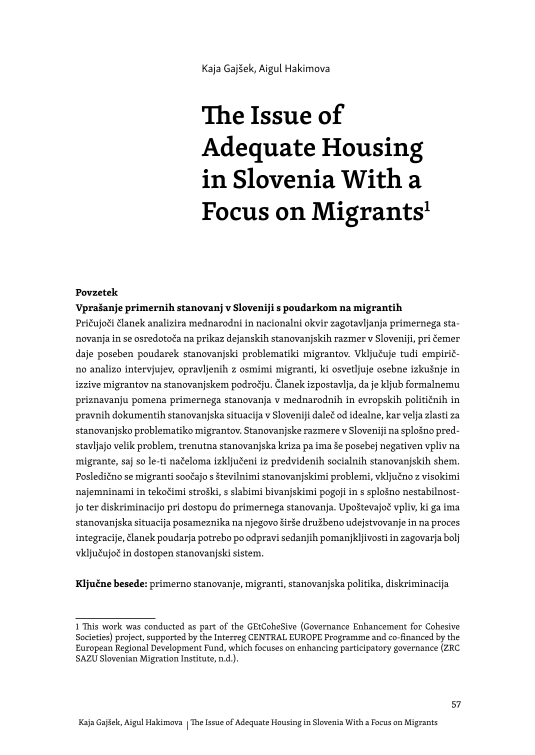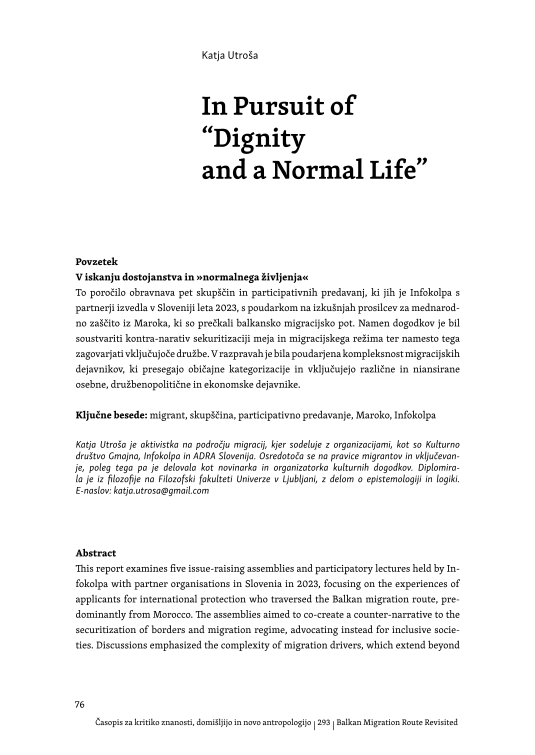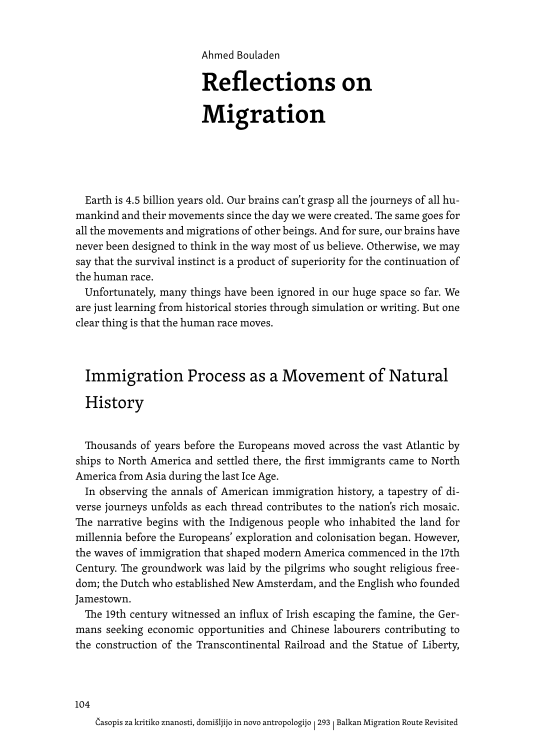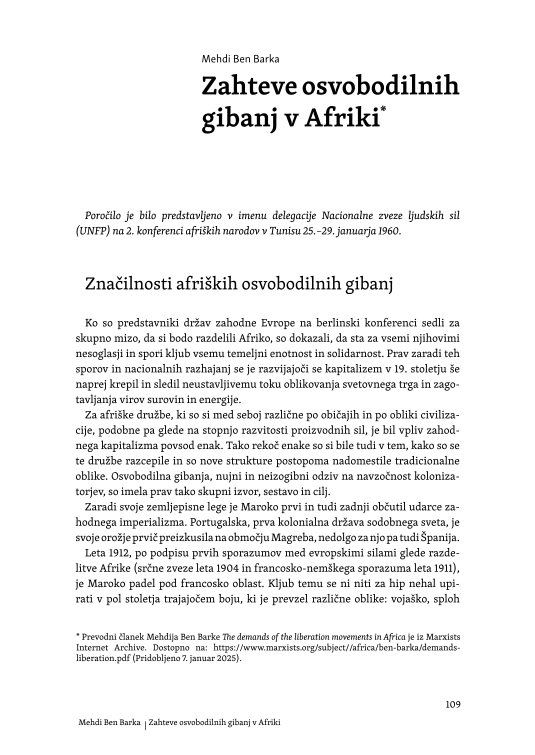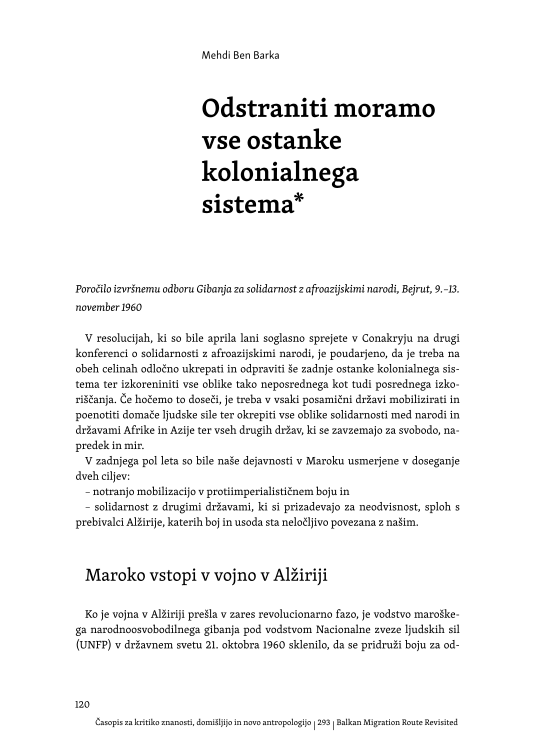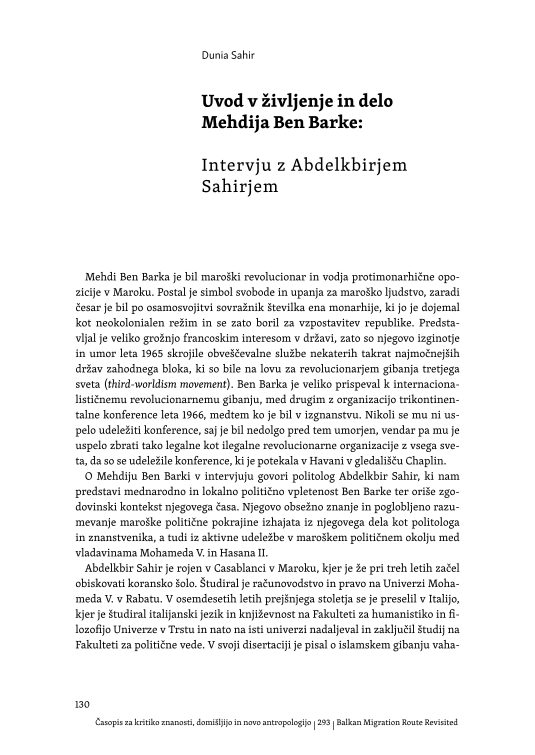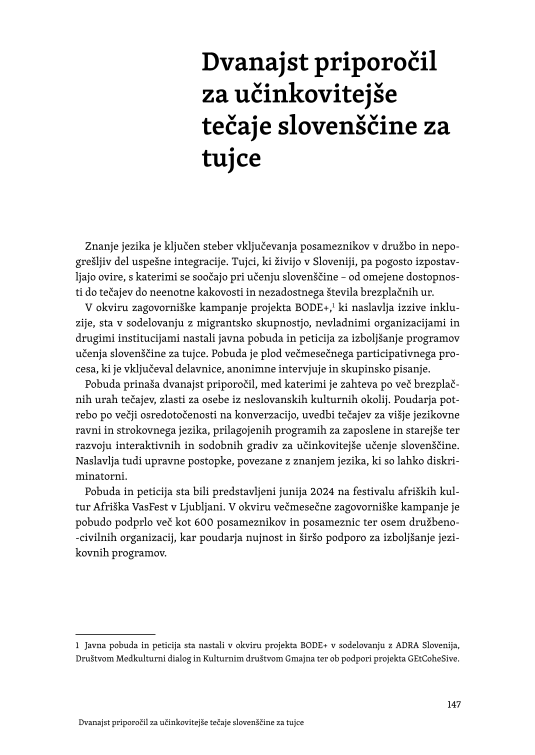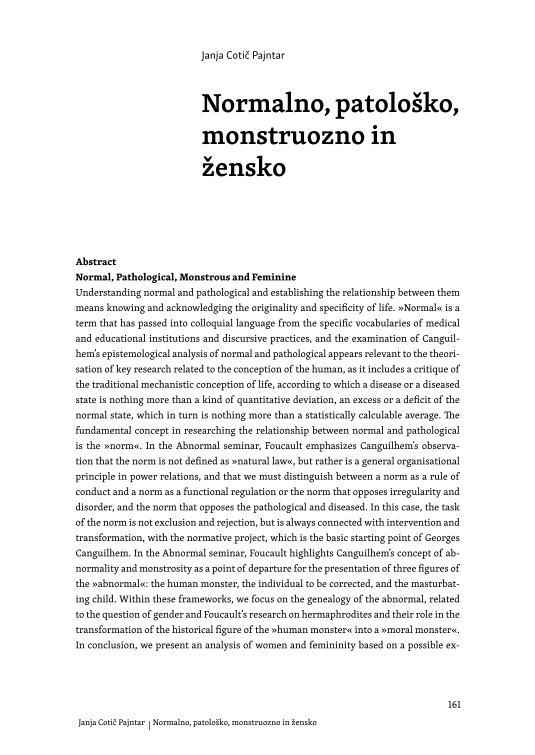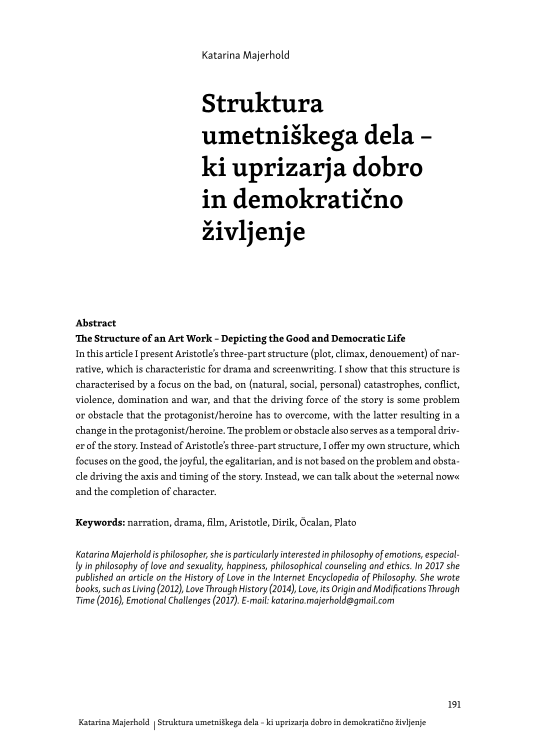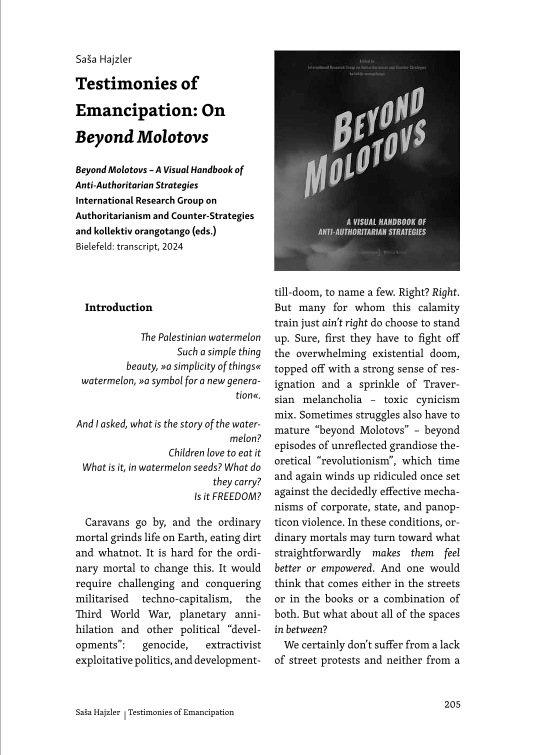Migrating is a way of life.
The bilingual texts, in English and Slovenian, stem from the Infokolpa collective’s activities over the past few years. They address excerpts from the Balkan migration route, which stretches across the Balkan Peninsula. They also examine the challenges of inclusion in Slovenia and investigate the situation in Morocco, a frequent country of origin.
Infokolpa has its roots in the struggles for freedom of movement at the now demolished Rog Autonomous Factory in Ljubljana, in particular in the space Second Home, which was located in a building in the south-eastern part of the factory and functioned as a caravanserai offering shelter, food, clothing and socio-political support to people on the move after the opening of the Balkan migration corridor in 2015.
There is something about the cold that strips away all illusion. It was winter 2017 when I crossed the border from Turkey to Greece and landed in Thessaloniki. Fourteen of us, huddled together, braving the ice-cold night. Some had been pushed back before – tortured, jailed, and sent back again. No one stayed long in any one place. “We were arrested here last time,” they would say, moving us along like shadows in the night. More than ten hours of walking through freezing rain, numb from the cold but unable to stop. That night felt like it would never end.
Cold has a way of breaking you down. I remember other freezing nights too. As a child in Tehran and Sanandaj, I stood in long lines with my mother for oil, shivering in the snow. But no memory could prepare me for that border. The brutality of it all. Six years have passed since, and yet that night haunts me. I am one of the lucky ones – lucky to no longer be there, waiting in fear and cold. But others are still there, trapped, stripped bare by men who wear uniforms and call themselves protectors.
They don’t just push you back, they strip you down – literally. The Greek border police beat us, took our clothes, money, and phones. Everything. They left people to die on the other side. I’ve seen the photos. Helpless bodies, abandoned. In the middle of it all, these men in power steal everything and send people back into the arms of death.
The article describes the shift in European border management, where a static border is transformed into a fluid and flexible regime with numerous internal and external borders. This new regime involves a myriad of public and private actors, both European and national, along with advanced technologies and diverse discourses. Its administration is increasingly becoming a space for the production of legal frameworks and population categories. This cross-border ‘industrial complex’ extends beyond the border areas themselves, across the whole of Europe, and, with the externalization of European migration management, to neighbouring countries and continents. The article describes some of the main features of moving borders: their deterritorialisation, privatisation, externalisation, and digitalisation. It concludes with an analysis of contemporary developments of the European border regime in South-East Europe and along the Balkan Route.
The article outlines some of the main changes in the Slovenian border regime in the past few years. The main change was a stop to the systematic practice of pushbacks on its southern border, which led to one of the biggest recorded numbers of irregular crossings since the closure of the Balkan Corridor in 2015. This also led to an emphasis on surrogate borders in the form of militarising the border through surveillance technology and the adamant perseverance of administrative obstacles in not enabling possibilities for legalisation. Even though the suspension of systematic pushbacks relocated some contradictions of the border regime inwards which was primarily noticeable in the overcrowding of asylum camps and failure to provide conditions for fundamental rights of asylum seekers, the Slovenian border regime remains entangled in its impermeable fortress. The article follows some changes in Slovenian border politics through three aspects: 1.) outline of irregular crossings since 2014 and permutations of the border regime on the border itself, 2.) Slovenia as a transit country and situation of asylum camps and 3.) militarisation of the Slovenian border through surveillance technology.
The present article provides an analysis of the international and national framework regarding adequate housing and focuses on highlighting the housing conditions in Slovenia, with a specific emphasis on the housing situation of migrants. It includes an empirical component, which consists of interviews conducted with eight migrants, shedding light on their personal experiences and challenges concerning housing. The article argues that, despite formal recognition of the importance of adequate housing in international and European policy documents, the housing conditions in Slovenia, particularly those of migrants, are far from adequate. The housing situation in Slovenia is highly problematic in general, but the current housing crisis has a particularly negative impact on migrants as they are mostly excluded from the limited social housing schemes available. They are, therefore, facing many issues related to housing, including high rent and utility costs, poor living conditions, as well as general instability and discrimination in accessing adequate housing. Given the profound impact of housing on broader social outcomes and on the integration process, the present article emphasizes the need to address the current shortcomings and advocates for a more inclusive and accessible housing system.
This report examines five issue-raising assemblies and participatory lectures held by Infokolpa with partner organisations in Slovenia in 2023, focusing on the experiences of applicants for international protection who traversed the Balkan migration route, predominantly from Morocco. The assemblies aimed to co-create a counter-narrative to the securitization of borders and migration regime, advocating instead for inclusive societies. Discussions emphasized the complexity of migration drivers, which extend beyond conventional categorizations to include diverse and nuanced personal, socio-political and economic factors.
Earth is 4.5 billion years old. Our brains can’t grasp all the journeys of all humankind and their movements since the day we were created. The same goes for all the movements and migrations of other beings. And for sure, our brains have never been designed to think in the way most of us believe. Otherwise, we may say that the survival instinct is a product of superiority for the continuation of the human race.
Unfortunately, many things have been ignored in our huge space so far. We are just learning from historical stories through simulation or writing. But one clear thing is that the human race moves.
Poročilo je bilo predstavljeno v imenu delegacije Nacionalne zveze ljudskih sil (UNFP) na 2. konferenci afriških narodov v Tunisu 25.–29. januarja 1960.
Značilnosti afriških osvobodilnih gibanj
Ko so predstavniki držav zahodne Evrope na berlinski konferenci sedli za skupno mizo, da si bodo razdelili Afriko, so dokazali, da sta za vsemi njihovimi nesoglasji in spori kljub vsemu temeljni enotnost in solidarnost. Prav zaradi teh sporov in nacionalnih razhajanj se je razvijajoči se kapitalizem v 19. stoletju še naprej krepil in sledil neustavljivemu toku oblikovanja svetovnega trga in zagotavljanja virov surovin in energije.
Poročilo izvršnemu odboru Gibanja za solidarnost z afroazijskimi narodi, Bejrut, 9.–13. november 1960
V resolucijah, ki so bile aprila lani soglasno sprejete v Conakryju na drugi konferenci o solidarnosti z afroazijskimi narodi, je poudarjeno, da je treba na obeh celinah odločno ukrepati in odpraviti še zadnje ostanke kolonialnega sistema ter izkoreniniti vse oblike tako neposrednega kot tudi posrednega izkoriščanja. Če hočemo to doseči, je treba v vsaki posamični državi mobilizirati in poenotiti domače ljudske sile ter okrepiti vse oblike solidarnosti med narodi in državami Afrike in Azije ter vseh drugih držav, ki se zavzemajo za svobodo, napredek in mir.
An Introduction to the Life and Work of Mehdi Ben Barka – Interview With Abdelkbir Sahir
(
Mehdi Ben Barka je bil maroški revolucionar in vodja protimonarhične opozicije v Maroku. Postal je simbol svobode in upanja za maroško ljudstvo, zaradi česar je bil po osamosvojitvi sovražnik številka ena monarhije, ki jo je dojemal kot neokolonialen režim in se zato boril za vzpostavitev republike. Predstavljal je veliko grožnjo francoskim interesom v državi, zato so njegovo izginotje in umor leta 1965 skrojile obveščevalne službe nekaterih takrat najmočnejših držav zahodnega bloka, ki so bile na lovu za revolucionarjem gibanja tretjega sveta (third-worldism movement). Ben Barka je veliko prispeval k internacionalističnemu revolucionarnemu gibanju, med drugim z organizacijo trikontinentalne konference leta 1966, medtem ko je bil v izgnanstvu. Nikoli se mu ni uspelo udeležiti konference, saj je bil nedolgo pred tem umorjen, vendar pa mu je uspelo zbrati tako legalne kot ilegalne revolucionarne organizacije z vsega sveta, da so se udeležile konference, ki je potekala v Havani v gledališču Chaplin.
Language skills are crucial for individuals’ social inclusion and an indispensable part of successful integration. However, foreigners living in Slovenia often highlight the obstacles they face in learning Slovenian, ranging from limited availability of courses to inconsistent quality and an insufficient number of free language course hours.
As part of the advocacy campaign under the BODE+ project, which addresses inclusion challenges, a public initiative and petition were developed in collaboration with the migrant community, non-governmental organisations, and other institutions to improve Slovenian language learning programs for foreigners. The initiative is the outcome of a months-long participatory process involving workshops, anonymous interviews, and group writing.
Understanding normal and pathological and establishing the relationship between them means knowing and acknowledging the originality and specificity of life. »Normal« is a term that has passed into colloquial language from the specific vocabularies of medical and educational institutions and discursive practices, and the examination of Canguilhem’s epistemological analysis of normal and pathological appears relevant to the theorisation of key research related to the conception of the human, as it includes a critique of the traditional mechanistic conception of life, according to which a disease or a diseased state is nothing more than a kind of quantitative deviation, an excess or a deficit of the normal state, which in turn is nothing more than a statistically calculable average. The fundamental concept in researching the relationship between normal and pathological is the »norm«. In the Abnormal seminar, Foucault emphasizes Canguilhem’s observation that the norm is not defined as »natural law«, but rather is a general organisational principle in power relations, and that we must distinguish between a norm as a rule of conduct and a norm as a functional regulation or the norm that opposes irregularity and disorder, and the norm that opposes the pathological and diseased. In this case, the task of the norm is not exclusion and rejection, but is always connected with intervention and transformation, with the normative project, which is the basic starting point of Georges Canguilhem. In the Abnormal seminar, Foucault highlights Canguilhem’s concept of abnormality and monstrosity as a point of departure for the presentation of three figures of the »abnormal«: the human monster, the individual to be corrected, and the masturbating child. Within these frameworks, we focus on the genealogy of the abnormal, related to the question of gender and Foucault’s research on hermaphrodites and their role in the transformation of the historical figure of the »human monster« into a »moral monster«. In conclusion, we present an analysis of women and femininity based on a possible extension of Canguilhem’s research on normal and pathological along two possible paths of continuation. The first path leads through feminist theory, which connects mothers, monsters and machines, derived from Foucault’s reading of Canguilhem, which enables the introduction of Foucault’s poorly researched »woman’s question«, but leads him to the figure of the mother and limits it to the research of motherhood. The second path suggests the place Canguilhem assigns to psychoanalysis in the history of science, thematizing hysteria as pathological femininity and gender-specific abnormality in contrast to »normal« motherhood. It seems that it is with the help of Canguilhem that we can take a decisive step in the analysis of the woman who is not only a mother, but is connected to the figure of the hysteric and the research of »female« hysteria. In his late project of the »history of sexuality«, Foucault planned to investigate the relationship between the »woman, the mother and the hysteric«, but his untimely death prevented him from doing so.
In this article I present Aristotle’s three-part structure (plot, climax, denouement) of narrative, which is characteristic for drama and screenwriting. I show that this structure is characterised by a focus on the bad, on (natural, social, personal) catastrophes, conflict, violence, domination and war, and that the driving force of the story is some problem or obstacle that the protagonist/heroine has to overcome, with the latter resulting in a change in the protagonist/heroine. The problem or obstacle also serves as a temporal driver of the story. Instead of Aristotle’s three-part structure, I offer my own structure, which focuses on the good, the joyful, the egalitarian, and is not based on the problem and obstacle driving the axis and timing of the story. Instead, we can talk about the »eternal now« and the completion of character.
Beyond Molotovs – A Visual Handbook of Anti-Authoritarian Strategies. International Research Group on Authoritarianism and Counter-Strategies and kollektiv orangotango (eds.), Bielefeld: transcript, 2024
Introduction
The Palestinian watermelon
Such a simple thing
beauty, »a simplicity of things«
watermelon, »a symbol for a new generation«.
And I asked, what is the story of the watermelon?
Children love to eat it
What is it, in watermelon seeds? What do they carry?
Is it FREEDOM?



